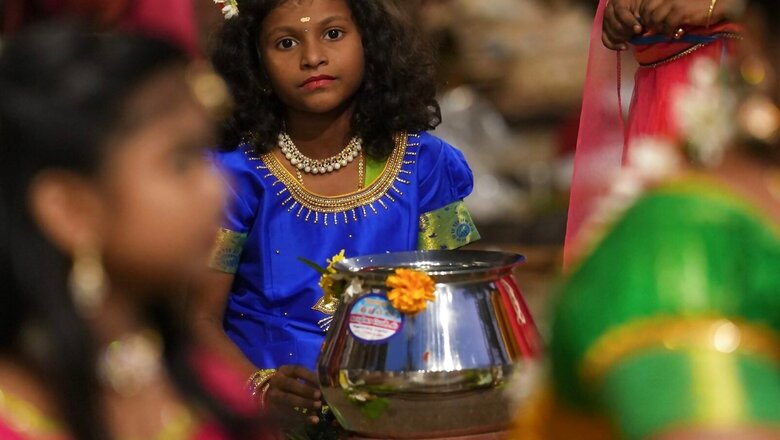
views
The Sun entered Makara Rashi (Sign of Capricorn) at 2046 hours on Saturday (January 14, 2023) marking the Makara Sankranti. The Makar Sankranti is singular, free from the trappings of tithi (lunar day), which marks almost every other Hindu religious festival. Yet, it might appear strange that Makara Sankranti, which is merely one transit of the Sun, out of a dozen annually, should be celebrated with such fanfare across India. It occasions Magh Bihu in Assam, Pausa or Pisthaka Sankranti in West Bengal and Tripura, Tila Sankranti in Bihar, Tai Pongal in Kerala, Tamil Nadu and Jaffna Peninsula of Sri Lanka, Uttarayana in Gujarat and Maharashtra, etc.
A closer analysis will reveal that celebrations are actually on account of Uttarayana Day, real or imagined, when the Sun “turns north”. Prime Minister Narendra Modi’s January 14 tweet (9.13 am) also confirms it. R Shamasastry (1912) cites reference from the Atharva Veda to prove that New Year in Vedic times began on Ekasthaka Day, eighth day of the dark half of the month of Magha, corresponding to December-January (The Vedic Calendar, P.1). Uttarayana Day is actually an event of the tropical solar calendar that can be identified with the Winter Solstice, the shortest day in the northern hemisphere. The Sun reaches its southernmost extremity on that day, and stands still on the Tropic of Capricorn at mid-day.
Like other events of the tropical calendar viz. Vernal Equinox, Summer Solstice and Autumnal Equinox, it should have no connection whatsoever with any zodiac sign. The zodiac signs are essentially stellar constellations lying far away from the solar system. However, the principles of tropical solar calendar never seem to have been overtly pursued in India. Thus Uttarayana Day was fixed with respect to Nakshatra (Asterisks or lunar mansions) rather than with respect to actual declination of the Sun on the celestial latitude. This was like building a castle on soft ground, vulnerable to subsidence. The impact of axial precession (previously called Precession of Equinoxes) amounting to 50˝.2 was never factored into. The correct modern value of the sidereal year is 365 days 6 hours 9 minutes and 98 seconds. It exceeds the tropical year of 365 days 5 hours 48 minutes and 45 seconds by approximately 20 minutes. This is almost double the difference that tropical year in the Julian calendar with the actual value.
“The mistake was found by Manjula and Sripati in the 10th and 11th centuries”, says Dr Meghnad Saha (1955), “when the Vernal Equinox had receded by seven to eight days, and they tried to persuade the astronomers to take to sayana reckoning but the attempt was unsuccessful” (Report of the Calendar Reform Committee, P.11). Dr Saha tried to argue that the beginning of sidereal solar calendar in India was actually from Vernal Equinox which was identified with entry of the Sun into the Mesa i.e. Sign of Aries (from where the Zodiac cycle begins). However, the actual Vernal Equinox has advanced significantly, or almost double that of the Julian calendar by the sixteenth century. The sidereal solar calendar is holding on the Mesa-Sankranti (which falls on April 14 or 15) as the Vernal Equinox as it is mistakenly holding on to Makar-Sankranti as Uttarayana. However, since India now follows the Gregorian calendar for all official and scientific purposes, we don’t feel the pinch of it. However, in reality the Indian sidereal solar calendar is straying from the seasons twice as rapidly as did the Gregorian calendar. This theoretically will have a long-term consequence for Hindu religious calendar.
One could not aver that the West never identified the seasons with zodiac signs. Its standing proofs are the nomenclature of Tropic of Cancer and Tropic of Capricorn, imaginary lines marking at 23˚27́N and 23˚27́S respectively on the globe. Possibly once upon a time the Sun used to be in the sign of Cancer on Summer Solstice and sign of Capricorn on Winter Solstice. Further, the Vernal Equinox point was identified as the “First Point Aries”. Thanks to axial precession that Equinox point has now retrograded into the Sign of Pisces. For the same reason, at present a gap of 23 days separates the Solstices from the respective zodiac signs they were identified with. Only the Sun Sign predictions, which appear in the newspaper columns, are still based on a fixed zodiac system. In the West, astronomy has proved to be progressive, and astrology retrograde. It has been reversed in India, where astrologers have adopted sidereal zodiacs, but almanac makers have not adopted tropical calendars. Sidereal principle is essential for astrology, but impediment for calendar making. Only the tropical calendar keeps the seasonal cycle firmly in place, with regard to the dates.
The date of Makar Sankranti has recognisably and permanently shifted since the late nineteenth century. The Bengali Almanac corresponding to 1874-75 AD proves that Uttarayana Sankranti (Makar Sankranti) came on January 12. John Murdoch’s Hindu and Muhammedan Festivals (1904) also put the date on January 12-13. The most authentic biography of Swami Vivekananda, while describing the natal chart of the famous monk, notes that he was born on January 12, 1863 on the Makar Sankranti day (The Life of Swami Vivekananda by his Eastern and Western Disciples in Two Volumes Vol-1, P.11).
The Julian calendar was not based on a principle different from the Gregorian calendar. The difference was only in determining the true length of the solar year. The Julian calendar had put it exactly at 365 and 6 hours, but the Gregorian calendar correctly reduced it to 365 days 5 hours and 48 minutes based on observations. The superfluous 11 minutes per year were responsible for the calendar year overshooting the natural year by around 15 days between 44 BC and 1582 AD. The Catholic Church laboured for more than thousand years to correct this error though out of ecclesiastical rather than any scientific motive. The placement of Easter, the principal movable feast of the Church, depended on the placement of the Vernal Equinox on the calendar. However, whatever be the motive, it was to the credit of the Catholic Church that it undertook this exercise successfully.
Pope Gregorian XIII ‘s reforms were no arbitrary exercise in papal authority. His reformation was preceded by precision observations of the movements of the Sun with the aid of large astronomical instruments installed in Rome, Florence and Bologna. The project, involving several mathematicians, was led by Father Ignazio Danti (1536-1586), the Dominican Priest who was also a gifted mathematician, astronomer and cosmographer. Pope Gregory’s reform of ‘annihilating’ ten days in October, 1582 was shocking to the contemporaneous world, and his reforms were rejected for a long time by the Eastern Orthodox and Protestant nations. Yet, they all accepted his reformation subsequently, as it was based on firm astronomical and scientific principles.
The problem of the Indian calendar was very different. To begin, India always had a multiplicity of reckoning systems involving Sun, Moon and Zodiac signs. There were two different ways of reckoning lunar months viz. amanta and purnimanta as mentioned above. India could never shed the sidereal solar principle in the reckoning year. Moreover, Hinduism never had a unifying central authority. It was not before 1905 that a Shankaracharya (of Sharada Peeth) called for views on calendar reforms.
“The difference between the sidereal year and the tropical year” says Bal Gangadhar Tilak (1893), “is 20.4 minutes, which causes the seasons to fall back nearly one lunar month in about every two thousand years, if the sidereal solar year is taken as the standard of measurement” (The Orion, P.19). Tilak was one of the earlier advocates of calendar reforms. It was only in the late nineteenth century that the advocacy for reforming the Indian calendar began. There was a clamour for recasting the Indian solar calendar on tropical (sayana) basis instead of sidereal (nirayana) basis.
Given the peculiarities of the Indian calendar, switching on to sayana system occurred only at the official level a decade after India became independent. The recommendations of the Calendar Reform Committee (1955) chaired by Dr Meghnad Saha, eminent astrophysicist and Member of Parliament, led to the adoption of a tropical solar calendar called Rashtriya Panchang. Its publication started in the 1879 Saka Era (1957-58 AD). The Committee had dropped 23 days, and put the beginning of the Indian solar year on March 22 of the Vernal Equinox. Its impact, however, was nothing compared to Pope Gregorian’s reforms. Though Rastriya Panchang forms the basis of Government of India’s official Saka Samvat (Reformed) calendar, it has found few takers amongst almanac makers of India.
Most almanac makers continue to adhere to the sidereal (nirayana) method of reckoning. Calendar could not be completely dissociated from culture, especially in India, where religious events are determined as per luni-solar calendar. Therefore, we will have to live with the 23-day difference between actual Uttarayana Day and Makar Sankranti.
The writer is an independent researcher based in New Delhi. The views expressed herein are his personal.
Read all the Latest Opinions here

















Comments
0 comment